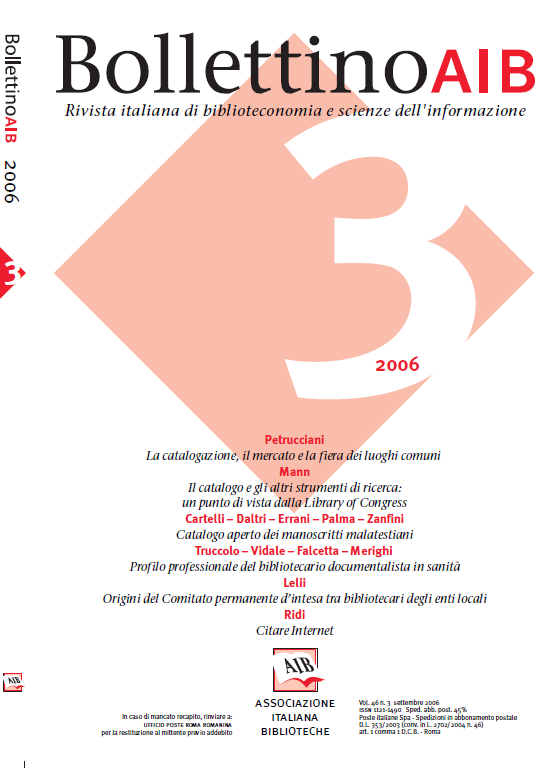Il catalogo aperto dei manoscritti malatestiani
Contenuto principale dell'articolo
Abstract
The open catalogue of the manuscripts of the Malatestiana Library, over three years after the presentation of the initial project maintains intact the topicality of the structure and of the initially hypothesized functions; it would however be much too limiting to stop only at its description, omitting an analysis of the consequences that it has and can have on the way of studying the manuscripts and working with them.
For reasons of simplicity and convenience the part regarding the characterization of the constitutive elements of the system is separate from more general consideration which, like in many other branches of learning, are opening the road to radically new study and research contexts. It should obviously be noted that the open catalogue, created for use by every library with manuscript collections with the aim of giving them back the central role of cultural production that they had in centuries past (at the time of the great erudition), is characterized by its elasticity and dynamicity in comparison to the corresponding closure and static nature of a printed catalogue. It is, in many ways, an information system (in the most truly informatic sense of the term) that is made up of ensemble of the human, hardware and software resources necessary for managing documentary information and it bases its structure and its functions on the intensive use of information and communication technologies.
By its nature the open catalogue is not therefore a system that can be identifies with a specific hardware and/or software product; it is rather a project, a container, a collection of processes and procedures that can avail of technologies for managing information and the relations that find a place and are established within it.
In its general structure, the open catalogue is divided into different sections, to be taken as being of a flexible nature at least in the initial phase, in the sense that each library that decides to adopt it can activate more or less of it, depending on its available funds and capacity, and in such a way that each of them can be managed in the times and manners that its human and financial resources permit.
If the open catalogue appears with a strong innovative character for the instruments uses and methods proposed, what is of even revolutionary importance is the effect that it has and could have on the way to carry out studies and research in the field of manuscripts and on the formation of future scholars of classic and medieval texts.
For reasons of simplicity and convenience the part regarding the characterization of the constitutive elements of the system is separate from more general consideration which, like in many other branches of learning, are opening the road to radically new study and research contexts. It should obviously be noted that the open catalogue, created for use by every library with manuscript collections with the aim of giving them back the central role of cultural production that they had in centuries past (at the time of the great erudition), is characterized by its elasticity and dynamicity in comparison to the corresponding closure and static nature of a printed catalogue. It is, in many ways, an information system (in the most truly informatic sense of the term) that is made up of ensemble of the human, hardware and software resources necessary for managing documentary information and it bases its structure and its functions on the intensive use of information and communication technologies.
By its nature the open catalogue is not therefore a system that can be identifies with a specific hardware and/or software product; it is rather a project, a container, a collection of processes and procedures that can avail of technologies for managing information and the relations that find a place and are established within it.
In its general structure, the open catalogue is divided into different sections, to be taken as being of a flexible nature at least in the initial phase, in the sense that each library that decides to adopt it can activate more or less of it, depending on its available funds and capacity, and in such a way that each of them can be managed in the times and manners that its human and financial resources permit.
If the open catalogue appears with a strong innovative character for the instruments uses and methods proposed, what is of even revolutionary importance is the effect that it has and could have on the way to carry out studies and research in the field of manuscripts and on the formation of future scholars of classic and medieval texts.
Dettagli dell'articolo
Fascicolo
Sezione
Articoli

Questo lavoro è fornito con la licenza Creative Commons Attribuzione - Condividi allo stesso modo 4.0.
